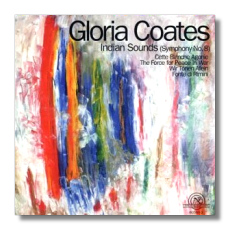
The Internet's Premier Classical Music Source
Related Links
- G. Coates Reviews
- Latest Reviews
- More Reviews
-
By Composer
-
Collections
DVD & Blu-ray
Books
Concert Reviews
Articles/Interviews
Software
Audio
Search Amazon
Recommended Links
Site News
 CD Review
CD Review
Gloria Coates

Indian Sounds
- Cette blanche agonie
- Symphony #8 "Indian Sounds"
- The Force for Peace in War
- Wir Tönen Allein
- Fragment from Leonardo's Notebooks, "Fonte di Rimini"
Sigune von Osten, soprano
Jürgen Wirrmann, Matthias Kuntzsch, conductors
Musica-viva-ensemble Dresden
Orchestra of the International Youth Festival, Bayreuth
New World 80599-2 ADD/DDD(?) 76:10
Gloria Coates (b. 1938), a Michigan-born composer with little exposure in the United States, has spent much of her creative life in Germany. Her music has been characterized by Robert Burns Neveldine as follows: "glacial semitonal and modal shifts, clustered chord progressions, hair-raising glissandi, and nonredemptive climaxes." Frequent glissandi and sonoristic effects have caused her to be compared to Penderecki, but Coates did not arrive at her unconventional and emotionally arresting style by simply copying the so-called "Polish School." This is not music to kick off your shoes and relax to; it demands the listener's involvement. Coates has commented, "My music expresses my inner world. I am not aware of its being terrifying, although it does express very basic feelings of life and death and joy as well as anxiety and pain."
Recently, a handful of Coates CDs has been released on the CPO and Naxos labels. This latest CD confirms that hers is an original and uncompromising talent. Like Sofia Gubaidulina, one shouldn't categorize Coates as a "woman composer" – she is a composer who just happens to be a woman. New World Records is devoted to the dissemination of music by American composers. Now that Coates's music has appeared in its catalog, perhaps she will receive the recognition that is her due in the United States.
All of the music on this CD involves the human voice. Cette blanche agonie and Wir Tönen Allein are settings of Mallarmé and Celan, respectively. The Force for Peace in War is cantata which sets "found texts" from World War Two. They are conventional works only in the sense that they treat the voice vocally, if you will. The other two works – the Symphony #8 and Fonte di Rimini – treat the voices more instrumentally. Texts are used, but the listener probably will not be able to tease them out from the music's fabric. In Coates's words, "The texts… should not be understood. The music is text really… the text itself is used as part of the music abstractly."
The cantata, the most ambitious work here, and the earliest, was written in 1973, a few years after Coates went to Germany. It is not entirely successful, but it is intriguing to compare the instrumental "Hiroshima is Bombed" movement with Penderecki's Threnody for the Victims of Hiroshima. The Eighth Symphony draws upon Native American music. It would be hard to find classical music inspired by Native Americans that, while recognizably "Indian," is less clichéd than this. The three movements ("Indian Grounds," "Indian Mounds," and "Indian Rounds") evoke a haunting spirit-world that is ever-present but intangible. Fonte di Rimini is also terribly striking and evocative. A letter by Leonardo da Vinci directs its recipient to "make a harmony with different falls of water, as you saw at the fountain of Rimini," and that is exactly what Coates has done through music. A quartet of singers performs the text syllabically; slowly gliding downwards in pitch as the orchestra itself rises up and falls down via long glissandos. The effect, while it has the incredible eeriness of slow-motion cinematography, is also unforgettably beautiful.
These are German performances, and as Coates was this disc's executive producer, I assume they present the music to her satisfaction. These are not top-name singers and instrumentalists, but they perform Coates's music with skill and conviction. Now let's see some American musicians take note. These are live recordings from 1992 and 1984. Although, the sound lacks a little studio polish, it is very acceptable.
As one expects from New World, the booklet notes are thorough and handsomely done. The strange, colorful cover painting is by Coates – yes, she's an abstract artist too, and her paintings are cut from the same fine cloth as her music.
Copyright © 2002, Raymond Tuttle


















